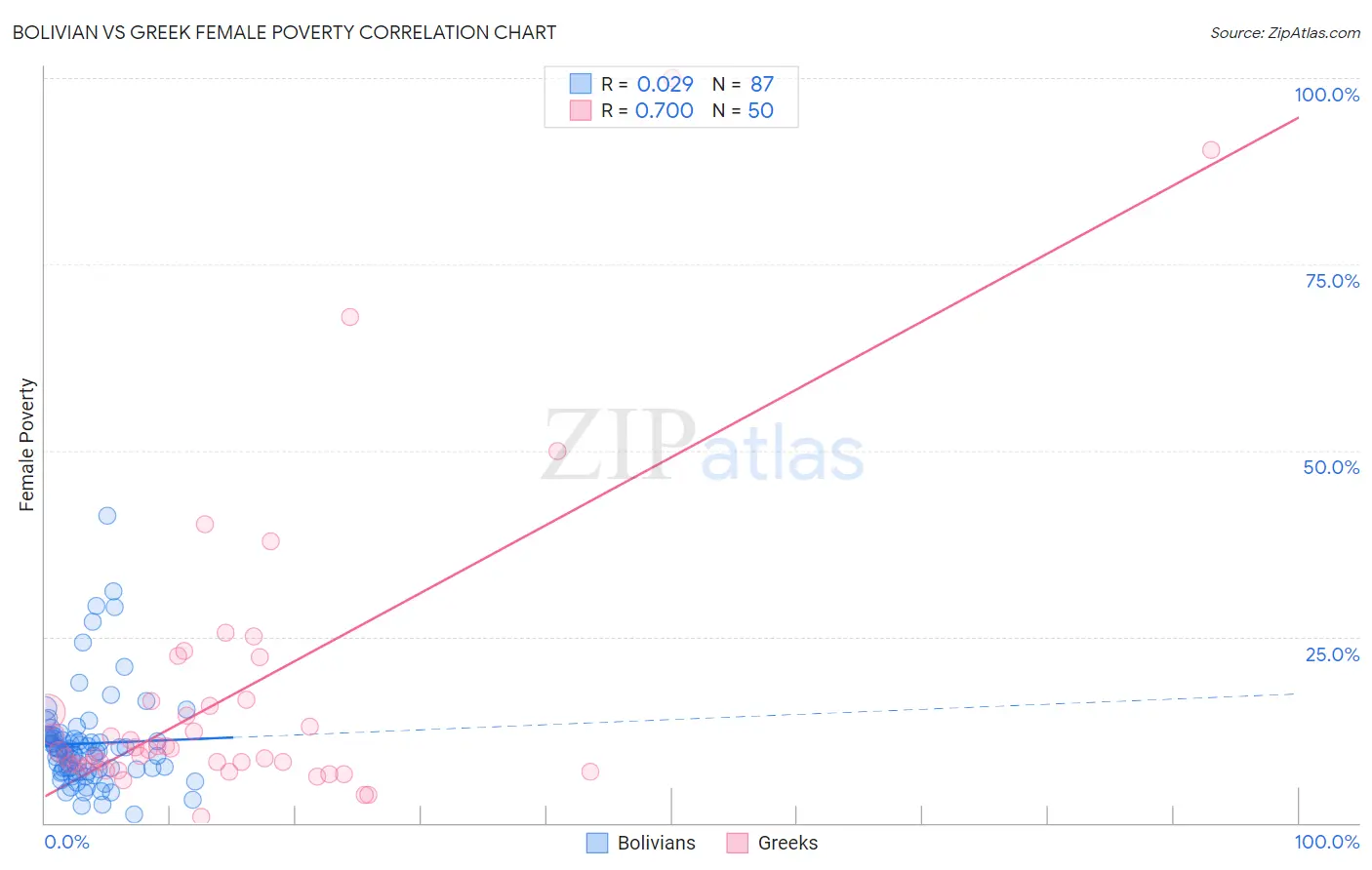Bolivian vs Greek Female Poverty
COMPARE
Bolivian
Greek
Female Poverty
Female Poverty Comparison
Bolivians
Greeks
11.5%
FEMALE POVERTY
99.8/ 100
METRIC RATING
17th/ 347
METRIC RANK
11.7%
FEMALE POVERTY
99.5/ 100
METRIC RATING
30th/ 347
METRIC RANK
Bolivian vs Greek Female Poverty Correlation Chart
The statistical analysis conducted on geographies consisting of 184,615,505 people shows no correlation between the proportion of Bolivians and poverty level among females in the United States with a correlation coefficient (R) of 0.029 and weighted average of 11.5%. Similarly, the statistical analysis conducted on geographies consisting of 482,170,203 people shows a significant positive correlation between the proportion of Greeks and poverty level among females in the United States with a correlation coefficient (R) of 0.700 and weighted average of 11.7%, a difference of 1.8%.

Female Poverty Correlation Summary
| Measurement | Bolivian | Greek |
| Minimum | 1.1% | 0.85% |
| Maximum | 41.2% | 100.0% |
| Range | 40.1% | 99.2% |
| Mean | 10.7% | 17.3% |
| Median | 9.7% | 9.9% |
| Interquartile 25% (IQ1) | 6.9% | 7.9% |
| Interquartile 75% (IQ3) | 11.6% | 16.3% |
| Interquartile Range (IQR) | 4.7% | 8.5% |
| Standard Deviation (Sample) | 6.6% | 20.2% |
| Standard Deviation (Population) | 6.5% | 20.0% |
Demographics Similar to Bolivians and Greeks by Female Poverty
In terms of female poverty, the demographic groups most similar to Bolivians are Immigrants from Scotland (11.5%, a difference of 0.050%), Immigrants from Bolivia (11.5%, a difference of 0.070%), Norwegian (11.5%, a difference of 0.090%), Eastern European (11.5%, a difference of 0.32%), and Latvian (11.4%, a difference of 0.54%). Similarly, the demographic groups most similar to Greeks are Immigrants from North Macedonia (11.7%, a difference of 0.080%), Polish (11.7%, a difference of 0.22%), Immigrants from Korea (11.7%, a difference of 0.23%), Danish (11.7%, a difference of 0.35%), and Cypriot (11.8%, a difference of 0.42%).
| Demographics | Rating | Rank | Female Poverty |
| Immigrants | Lithuania | 99.9 /100 | #13 | Exceptional 11.3% |
| Lithuanians | 99.8 /100 | #14 | Exceptional 11.4% |
| Latvians | 99.8 /100 | #15 | Exceptional 11.4% |
| Immigrants | Bolivia | 99.8 /100 | #16 | Exceptional 11.5% |
| Bolivians | 99.8 /100 | #17 | Exceptional 11.5% |
| Immigrants | Scotland | 99.8 /100 | #18 | Exceptional 11.5% |
| Norwegians | 99.8 /100 | #19 | Exceptional 11.5% |
| Eastern Europeans | 99.7 /100 | #20 | Exceptional 11.5% |
| Italians | 99.7 /100 | #21 | Exceptional 11.6% |
| Swedes | 99.7 /100 | #22 | Exceptional 11.6% |
| Burmese | 99.7 /100 | #23 | Exceptional 11.6% |
| Luxembourgers | 99.7 /100 | #24 | Exceptional 11.6% |
| Immigrants | Northern Europe | 99.6 /100 | #25 | Exceptional 11.6% |
| Croatians | 99.6 /100 | #26 | Exceptional 11.6% |
| Iranians | 99.6 /100 | #27 | Exceptional 11.7% |
| Immigrants | Korea | 99.6 /100 | #28 | Exceptional 11.7% |
| Immigrants | North Macedonia | 99.6 /100 | #29 | Exceptional 11.7% |
| Greeks | 99.5 /100 | #30 | Exceptional 11.7% |
| Poles | 99.5 /100 | #31 | Exceptional 11.7% |
| Danes | 99.5 /100 | #32 | Exceptional 11.7% |
| Cypriots | 99.5 /100 | #33 | Exceptional 11.8% |